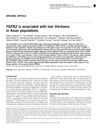Common Variants in the Trichohyalin Gene Are Associated with Straight Hair in Europeans
November 2009
in “
American journal of human genetics
”
TLDR Common variants in the Trichohyalin gene are linked to straight hair in Europeans.
The study identified that common variants in the Trichohyalin (TCHH) gene were associated with straight hair in Europeans, explaining approximately 6% of the variance in hair morphology. Researchers conducted a genome-wide association study (GWAS) involving 4,845 individuals of European descent and found four highly correlated SNPs on chromosome 1q21.3, with rs11803731 being the most notable. These findings highlighted the genetic basis of hair morphology differences and suggested potential natural or sexual selection influences on these traits.

